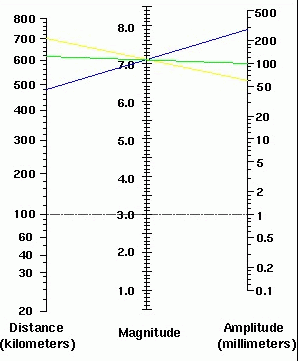The Indian Ocean Earthquake that struck the coast of Indonesia in 2004 was registered as a 9.0 magnitude earthquake. Magnitude is a measurement of the energy released from an earthquake and is measured on a Richter scale, usually with a reading between 2 and 9. Earthquakes of magnitude 8.0 or greater are very rare and can completely destroy anything near the epicenter. The Richter scale measurements are logarithmic base 10, which means that an earthquake of magnitude 9.0 would be 10 times as strong as an earthquake of magnitude 8.0. Similarly, an earthquake of magnitude 9.0 would be 104 times as powerful as an earthquake that measured 5.0. Using the distance from the S-P interval time and the maximum amplitude, both of which are recorded on a seismograph, experts can use the base 10 logarithms to find the magnitude of the earthquake.
The Richter scale is based on a standard measurement: an earthquake that can be felt 100km away with amplitude of 1mm is given a magnitude measurement of 3.0. This is the base measurement and all other measurements of magnitude are made to this reference. As a result, an earthquake that is 100km away, but has an amplitude measurement of 10mm would measure 4.0. The following graph shows this relationship and outlines the base reference standard at magnitude 3.0.
 Image reproduced with permission of Geology Labs Online |
A straight line is drawn from the distance measurement to the amplitude measurement of the three seismographs. The three lines should all meet at a single point on the magnitude scale in the middle, giving a magnitude reading for the earthquake.
